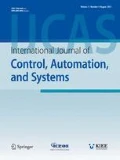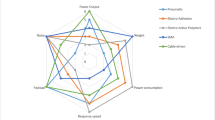Abstract
In this paper, an efficient and probabilistic complete planning algorithm called Composite-space RRT is presented to address motion planning with soft constraints for spherical wrist manipulators. Firstly, we propose a novel configuration space termed Composite Configuration Space (“Composite Space” for short), which is composed of the joint space and the task space. Then, collision-free paths are generated in the composite space by the Rapidly-exploring Random Trees (RRT) algorithm. Finally, the planned paths in the composite space are mapped into the corresponding joint-space paths by a local planner. As the analytical inverse kinematics (IK) of the spherical wrist is used in the local planner, the proposed Composite-space RRT algorithm is characterized by high efficiency and no numerical iteration. Moreover, this approach can effectively improve the smoothness of the end-effector orientation path. The effectiveness of the proposed algorithm is demonstrated on the Willow Garage’s PR2 simulation platform with two typical orientation-constrained cases.
Similar content being viewed by others
References
T. Kunz and M. Stilman, “Manipulation planning with soft task constraints,” Proc. of IEEE/RSJ International Conference on Intelligent Robots and Systems, pp. 1937–1942, 2012.
Z. Kingston, M. Moll, and L. E. Kavraki, “Sampling-based methods for motion planning with constraints,” Annual Review of Control, Robotics, and Autonomous Systems, vol. 1, pp. 159–185, 2018.
J. Mirabel, S. Tonneau, P. Fernbach, A.-K. Seppälä, M. Campana, N. Mansard, and F. Lamiraux, “HPP: A new software for constrained motion planning,” Proc. of IEEE/RSJ International Conference on Intelligent Robots and Systems, pp. 383–389, 2016.
C. Milton and D. Jennings, “Path planning for a manipulator with constraints on orientation,” Journal of Intelligent & Robotic Systems, vol. 11, no.1–2, pp. 67–77, 1994.
B. Cohen, S. Chitta, and M. Likhachev, “Search-based planning for dual-arm manipulation with upright orientation constraints,” Proc. of IEEE International Conference on Robotics and Automation, pp. 3784–3790, 2012.
G. Oriolo, M. Cefalo, and M. Vendittelli, “Repeatable motion planning for redundant robots over cyclic tasks,” IEEE Trans. on Robotics, vol. 33, no. 5, pp. 1170–1183, 2017.
Y. Liu, C. Yu, J. Sheng, and T. Zhang, “Self-collision avoidance trajectory planning and robust control of a dualarm space robot,” International Journal of Control, Automation and Systems, vol. 16, no. 6, pp. 2896–2905, 2018.
S. M. Lavalle, J. H. Yakey, and L. E. Kavraki, “A probabilistic roadmap approach for systems with closed kinematic chains,” Proc. of IEEE International Conference on Robotics and Automation, pp. 1671–1676, 1999.
L. A. Tuan, Y. H. Joo, L. Q. Tien, and P. X. Duong, “Adaptive neural network second-order sliding mode control of dual arm robots,” International Journal of Control, Automation and Systems, vol. 15, no. 6, pp. 2883–2891, 2017.
N. Larkin, A. Short, Z. X. Pan, and S. V. Duin, “Task space motion planning decomposition,” Proc. of IEEE/RSJ International Conference on Intelligent Robots and Systems, pp. 1688–1694, 2018.
A. C. Shkolnik and R. Tedrake, “Path planning in 1000+dimensions using a task-space Voronoi bias,” Proc. of IEEE International Conference on Robotics and Automation, pp. 2061–2067, 2009.
M. Behnisch, R. Haschke, and M. Gienger, “Task space motion planning using reactive control,” Proc. of IEEE/RSJ International Conference on Intelligent Robots and Systems, pp. 5934–5940, 2010.
J. Lee and S. Yoon, “PROT: Productive regions oriented task space path planning for hyper-redundant manipulators,” Proc. of IEEE International Conference on Robotics and Automation, pp. 6491–6498, 2014.
J. Huh, B. Lee, and D. D. Lee, “Constrained sampling-based planning for grasping and manipulation,” Proc. of IEEE International Conference on Robotics and Automation, pp. 223–230, 2018.
D. Berenson, S. Srinivasa, and J. J. Kuffner, “Task space regions: A framework for pose-constrained manipulation planning,” Int. J. Robot. Res., vol. 30, no.12, pp. 1435–1460, 2011.
L. Jaillet and J. M. Porta, “Path planning under kinematic constraints by rapidly exploring manifolds,” IEEE Trans. on Robotics, vol. 29, no.1, pp. 105–117, 2013.
I. A. Sucan and S. Chitta, “Motion planning with constraints using configuration space approximations,” Proc. of IEEE/RSJ International Conference on Intelligent Robots and Systems, pp. 1904–1910, 2012.
M. Stilman, “Task constrained motion planning in robot joint space,” Proc. of IEEE/RSJ International Conference on Intelligent Robots and Systems, pp. 3074–3081, 2007.
B. Kim, T. T. Um, C. Suh, and F. C. Park, “Tangent bundle RRT: A randomized algorithm for constrained motion planning,” Robotica, vol. 34, no. 1, pp. 202–225, 2016.
J. Wang, S. Liu, B. Zhang, and C. Yu, “Inverse kinematics-based motion planning for dual-arm robot with orientation constraints,” Int. J. Adv. Robot. Syst., vol. 1, pp. 1–14, 2019.
M. Bonilla, E. Farnioli, L. Pallottino, and A. Bicchi, “Sample-based motion planning for robot manipulators with closed kinematic chains,” Proc. of IEEE International Conference on Robotics and Automation, pp. 2522–2527, 2015.
T. Lozanoperez and M. A. Wesley, “An algorithm for planning collision-free paths among polyhedral obstacles,” Communications of the ACM, vol. 22, no. 10, pp. 560–570, 1979.
S. P. Viswanathan, A. K. Sanyal, and R. Warier, “Finite-time stable tracking control for a class of underactuated aerial vehicles in SE(3),” Proc. of American Control Conference, pp. 3926–3931, 2017.
S. Liu, K. Mohta, N. Atanasov, and V. Kumar, “Search-based motion planning for aggressive flight in SE(3),” IEEE Robotics and Automation Letters, vol. 3, no. 3, pp. 2439–2446, 2018.
S. Kulumani and T. Lee, “Constrained geometric attitude control on SO(3),” International Journal of Control, Automation and Systems, vol. 15, no. 6, pp. 2796–2809, 2017.
S. M. Lavalle and J. J. Kuffner, “Rapidly-exploring random trees: progress and prospects,” Proc. of Algorithmic and Computational Robotics: New Directions, pp. 293–308, 2000.
J. J. Kuffner, “Effective sampling and distance metrics for 3D rigid body path planning,” Proc. of IEEE International Conference on Robotics and Automation, pp. 3993–3998, 2004.
K. Shoemake, “Animating rotation with quaternion curves”, Proc. of 12nd Annu. Conf. on Computer Graphics and interactive techniques, pp. 245–254, 1985.
D. Berenson and S. S. Srinivasaz, “Probabilistically complete planning with end-effector pose constraints,” Proc. of IEEE International Conference on Robotics and Automation, pp. 2724–2730, 2010.
J. Denavit and R. S. Hartenberg, “A kinematic notation for lower-pair mechanisms based on matrices,” ASME Journal of Applied Mechanics, vol. 2, no. 1, pp. 215–221, 1955.
S. Chitta, I. Sucan, and S. Cousins, “Moveit! [ros topics],” IEEE Robot. Autom. Mag., vol. 19, no. 1, pp. 18–19, 2012.
I. A. Sucan, M. Moll, and L. E. Kavraki, “The open motion planning library,” IEEE Robot. Autom. Mag., vol. 19, no. 4, pp. 72–82, 2012.
B. Cohen, S. Chitta, and M. Likhachev, “Single- and dualarm motion planning with heuristic search,” Int. J. Robot. Res., vol. 33, no. 2, pp. 305–320, 2014.
Author information
Authors and Affiliations
Corresponding author
Additional information
Publisher’s Note Springer Nature remains neutral with regard to jurisdictional claims in published maps and institutional affiliations.
Recommended by Associate Editor Augie Widyotriatmo under the direction of Editor Myo Taeg Lim. This work was supported by the NSFC-DFG Grant (No. 61761136005), the Key Research and Development Program of Zhejiang Province China (No. 2019C04018), NSFC Grant (No. 61503108), and 111 Project (No. D17019).
Jiangping Wang received his M.S. degree in control engineering from Hangzhou Dianzi, Hangzhou, China, in 2015. He is currently working toward a Ph.D. degree at the School of Automation, Hangzhou Dianzi University, Hangzhou, China. His current research interests include motion planning and intelligent robotics.
Shirong Liu received his B.Sc. degree in electrical engineering from Zhejiang University, Hangzhou, China, an M.Sc. degree in industrial automation from Chongqing University, Chongqing, China, and a Ph.D. degree in system and control from East China University of Science and Technology, Shanghai, China, in 1978, 1986, and 2000, respectively. His research interests include intelligent robotics, intelligent control, system modeling, and renewable-energy electric power systems and control.
Botao Zhang received his Ph.D. degree in control engineering from East China University of Science and Technology, Shanghai, China, in 2012. He is an Associate Professor at the School of Automation, Hangzhou Dianzi University, Hangzhou, China. His current research interest includes intelligent robotics.
Changbin Yu received his B.Eng. degree (Hons.) in computer engineering from Nanyang Technological University, Singapore, in 2004 and a Ph.D. degree from Australian National University, Canberra, ACT, Australia, in 2008. He obtained tenure with ANU in 2014 and still holds an Honorary Professorship. In 2017, he founded the AI and Robotics Centre, Westlake University, Hangzhou, China. He was appointed as the Optus Chair to establish the Optus-Curtin Centre of Excellence in AI, Curtin University, Perth, WA, Australia. Dr. Yu was a recipient of the Endeavour Asia Award, APD Fellowship, QEII Fellowship, and a 2019 John Booker Medal in Engineering. He received multiple grants from AAS and ATSE. He is a fellow of Engineers Australia.
Rights and permissions
About this article
Cite this article
Wang, J., Liu, S., Zhang, B. et al. Manipulation Planning with Soft Constraints by Randomized Exploration of the Composite Configuration Space. Int. J. Control Autom. Syst. 19, 1340–1351 (2021). https://doi.org/10.1007/s12555-019-0727-8
Received:
Revised:
Accepted:
Published:
Issue Date:
DOI: https://doi.org/10.1007/s12555-019-0727-8




